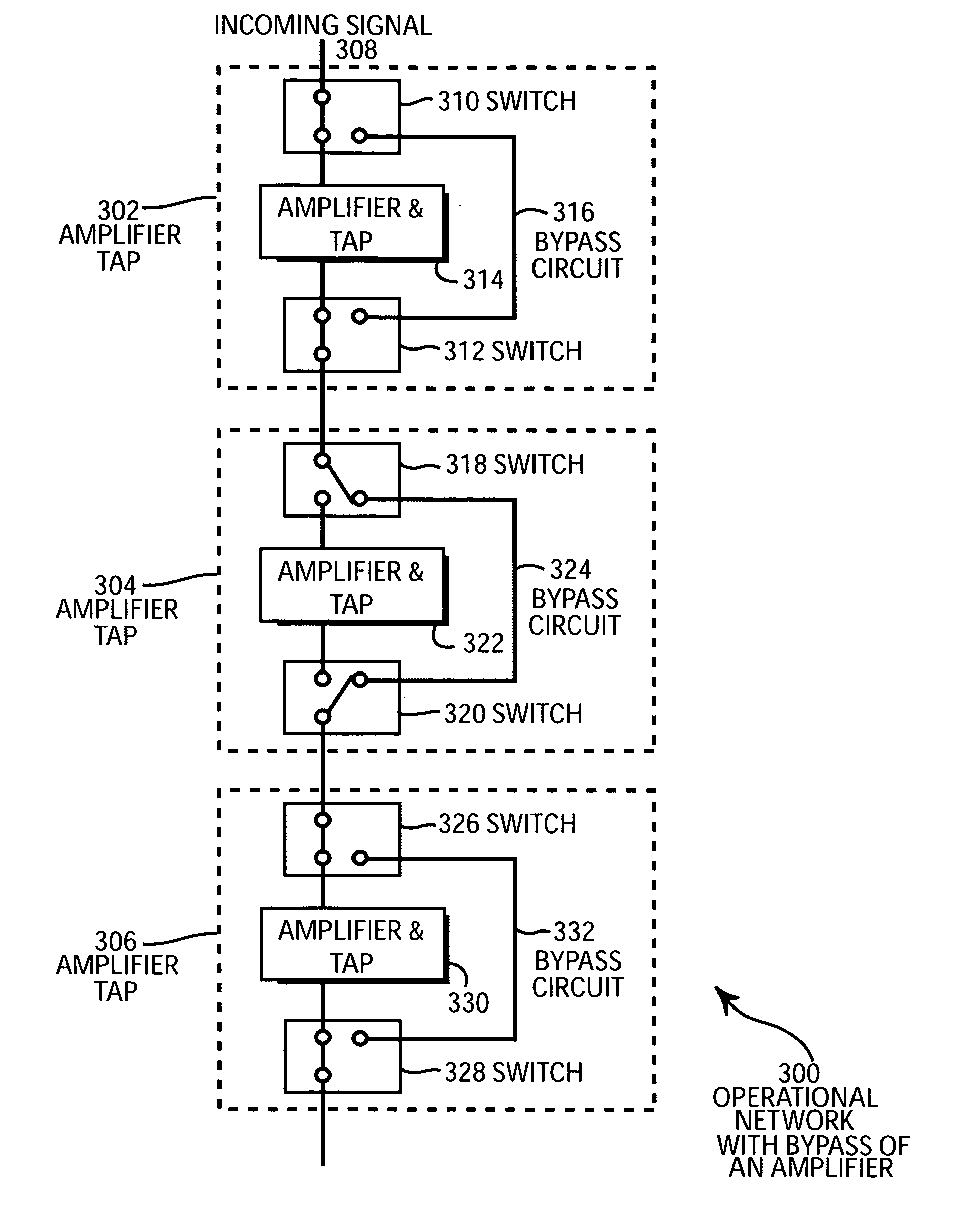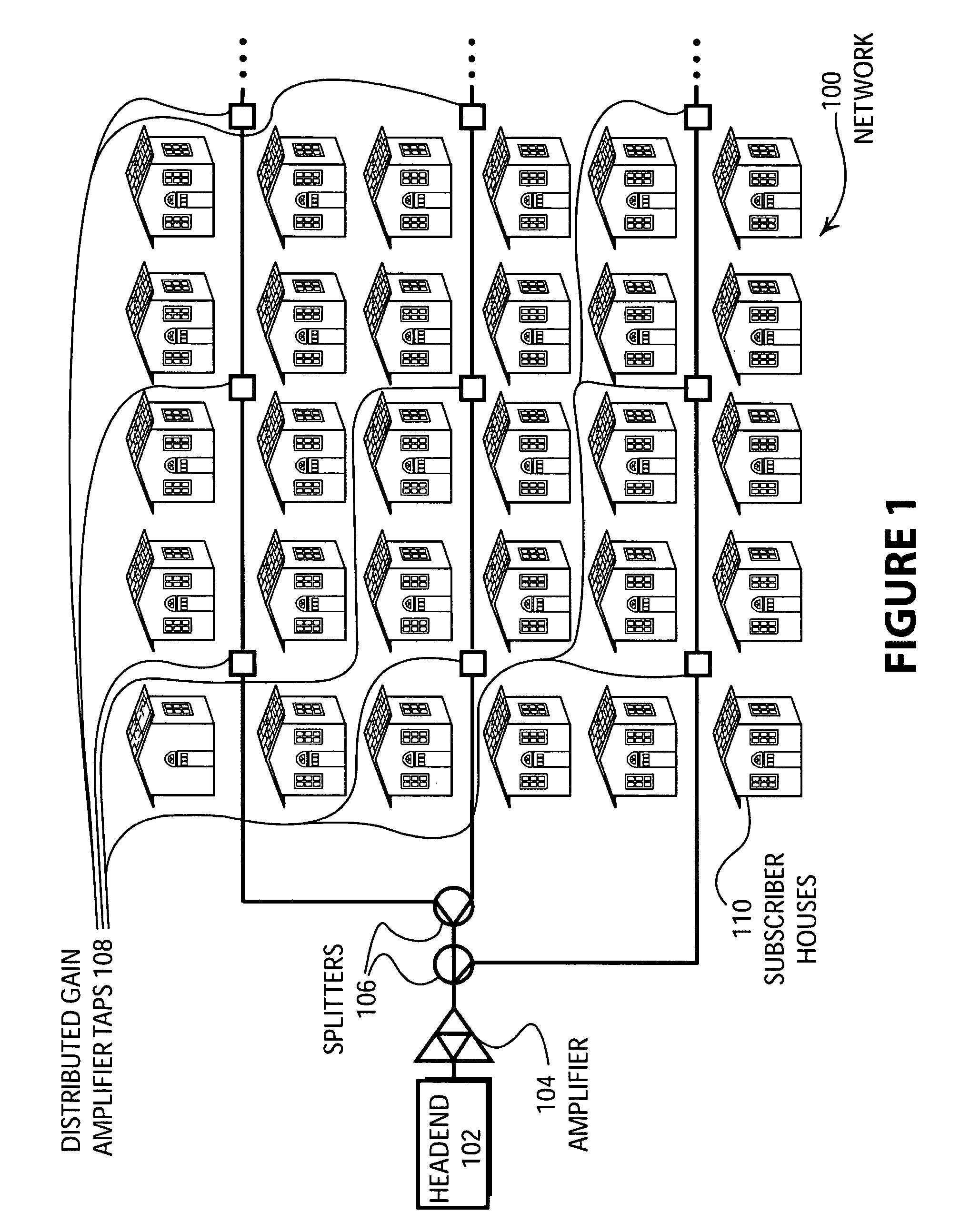Distributed gain network
a gain network and distribution network technology, applied in the direction of gated amplifiers, amplifiers with coupling networks, two-way working systems, etc., can solve the problems of large power consumption, complex devices for amplification of each stage, and increase the demand for amplifiers, so as to achieve low noise, simple amplifier devices, and low power amplification
- Summary
- Abstract
- Description
- Claims
- Application Information
AI Technical Summary
Benefits of technology
Problems solved by technology
Method used
Image
Examples
embodiment 100
[0026]FIG. 1 illustrates an embodiment 100 of the present invention of a distribution network 100. Cable and Digital Subscriber Lines (DSL) require “substantially linear” networks to carry highly complex modulation formats that mix amplitude, phase and frequency modulation (AM, PM and FM), which are also multi-carrier with high signal spectral densities. Systems for communicating information from a client device to a substantially linear broadband network have been contemplated in U.S. Pat. No. 6,377,782 issued to Bishop et al., which is hereby incorporated by reference for all it teaches and discloses. Cable telecommunication networks are made of long spans of coaxial and fiber cables, which are inherently subject to high signal loss. To replace lost signal amplitude (and maintain minimum signal-to-noise ratios) amplifiers are necessary. A purely linear amplifier, that is an amplifier with no non-linear terms in its gain equation, will simply increase the amplitude of all signals e...
embodiment 200
[0030]FIG. 2A illustrates an embodiment 200 of the present invention of an amplifier with a bypass mode. The amplifier housing 202 has an upstream input 204 and a downstream output 206. In many cases, bidirectional signals may be carried on both the upstream connection 204 and the downstream connection 206. A power tap 208 normally takes low frequency AC power off of the cable and transfers the power to a power supply 210 connected to a battery backup 212. A controller 214 connects to a bypass controller 216 to the amplifier tap and circuitry 218. The upstream signal is connected to a normally open switch 220, a normally closed switch 222, and a second normally open switch 224. The bypass controller 216 is operable to actuate the three switches 220, 222, and 224 in unison.
embodiment 201
[0031]FIG. 2B illustrates an embodiment 201 of the present invention of an amplifier with a bypass mode. The amplifier housing 202 has an upstream input 204 and a downstream output 206. In many cases, bidirectional signals may be carried on both the upstream connection 204 and the downstream connection 206. A power tap 208 normally takes low frequency AC power off of the cable and transfers the power to a power supply 210 connected to a battery backup 212. A controller 214 connects to a bypass controller 216 to the amplifier tap and circuitry 218. The upstream signal is connected to the switch 226, and a second switch 228. The switches 226 and 228 are capable of switching between the amplifier and tap circuitry 218 and the bypass circuit 230.
[0032]The embodiment 200 is an amplifier that is adapted to allow signals to bypass the amplifier and tap circuitry 218 when no power is applied to the amplifier, i.e., when the switches 220, 222 and 224 revert to their respective normal states ...
PUM
 Login to View More
Login to View More Abstract
Description
Claims
Application Information
 Login to View More
Login to View More - R&D
- Intellectual Property
- Life Sciences
- Materials
- Tech Scout
- Unparalleled Data Quality
- Higher Quality Content
- 60% Fewer Hallucinations
Browse by: Latest US Patents, China's latest patents, Technical Efficacy Thesaurus, Application Domain, Technology Topic, Popular Technical Reports.
© 2025 PatSnap. All rights reserved.Legal|Privacy policy|Modern Slavery Act Transparency Statement|Sitemap|About US| Contact US: help@patsnap.com



